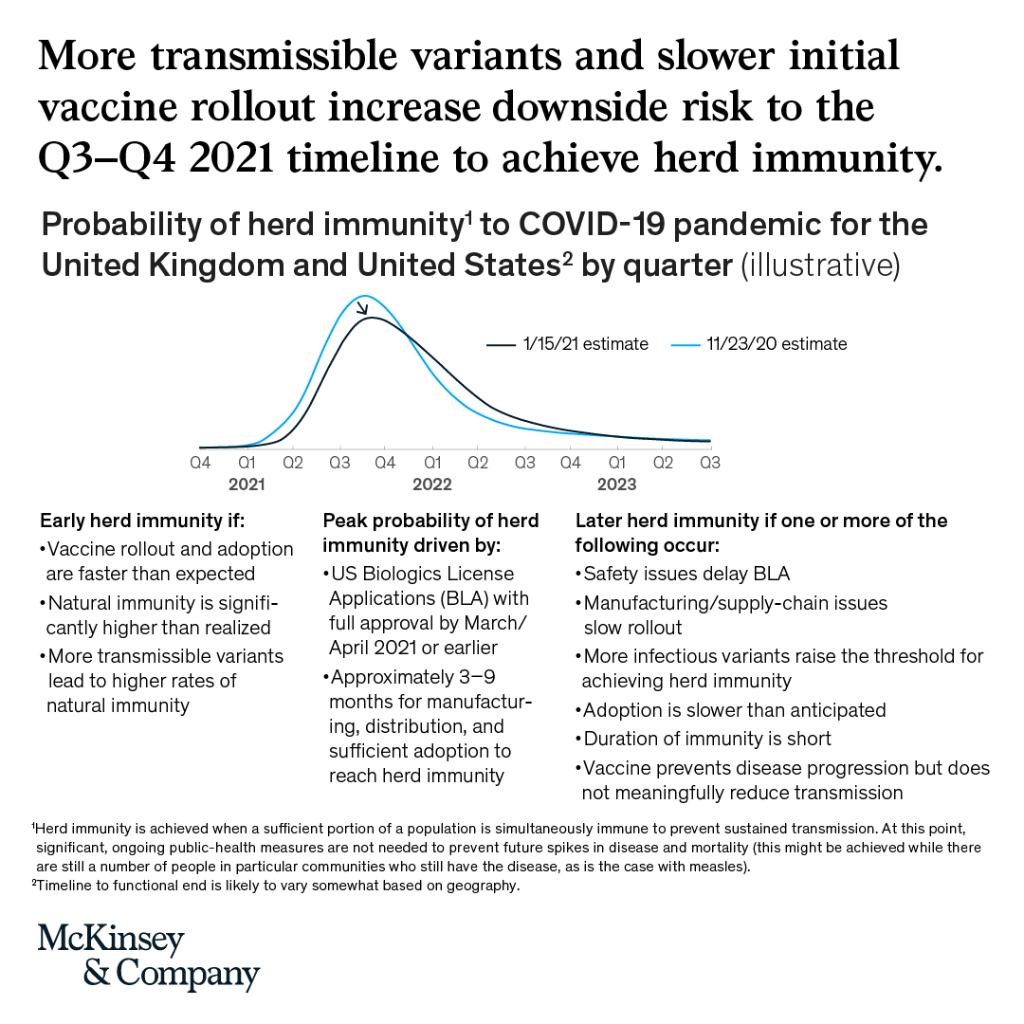When Will The Pandemic End?
Source: McKinsey & Company
This article updates our earlier perspectives on when the coronavirus pandemic will end. Transition toward normalcy in the United States remains most likely in the second quarter of 2021 and herd immunity in the third and fourth quarters, but the emergence of new strains and a slow start to vaccine rollout raise real risks to both timelines. We also add a perspective for the United Kingdom.
Margaret Keenan, a British nonagenarian, made history on December 8 by becoming the first person to receive the Pfizer-BioNTech vaccine for SARS-CoV-2 outside a clinical trial. Since then, several other vaccines have been authorized for use around the world. Sufficient doses are likely to be available to vaccinate high-risk populations in the United States in the first half of 2021. In parallel, however, more-infectious strains of the virus have been detected in South Africa, the United Kingdom, and elsewhere and have spread to an increasing number of countries. And the initial rollout of vaccines has been slower than hoped in many places.
While the United States could still achieve herd immunity in the third or fourth quarter of 2021 (in line with the peak probability in our previous estimates), the emergence of more-infectious variants of SARS-CoV-2 increases the risk that this milestone will not be achieved until later. More-infectious viruses require that a higher percentage of people be simultaneously immune to reach herd immunity.4 While a more infectious variant likely means more people are acquiring natural immunity through infection (despite ongoing efforts to minimize new cases), the net impact of more-infectious strains is likely to be that a higher portion of the population needs to be vaccinated, which may take more time.
We still believe that the United States can transition toward normalcy during the second quarter of 2021, but the same risks also threaten this timeline. A transition toward normalcy would be driven by a combination of seasonality aiding a decline in cases and early vaccine doses helping reduce mortality by protecting those at greatest risk of serious illness. As COVID-19’s impact on health wanes, we are likely to see greater normalization of social and economic life. Data on the availability of vaccine doses in the United States increase confidence that this is possible, but the slow start to the vaccine rollout reinforces that success is by no means guaranteed.
This article describes “most likely” timelines for when the coronavirus pandemic will end. It is now harder to imagine the United States or United Kingdom transitioning to normalcy before second quarter 2021 or reaching herd immunity before third quarter 2021. But a number of other factors could delay the timelines beyond those described, including unexpected safety issues emerging with early vaccines, significant manufacturing or supply-chain delays, continued slow adoption, further mutation, or a shorter-than-anticipated duration of vaccine-conferred immunity. Herd immunity will also require vaccines to be effective in reducing transmission of SARS-CoV-2, not just in protecting vaccinated individuals from getting sick. This is likely, but has not yet been proven at scale.

Read the full report here.


















































First, please LoginComment After ~